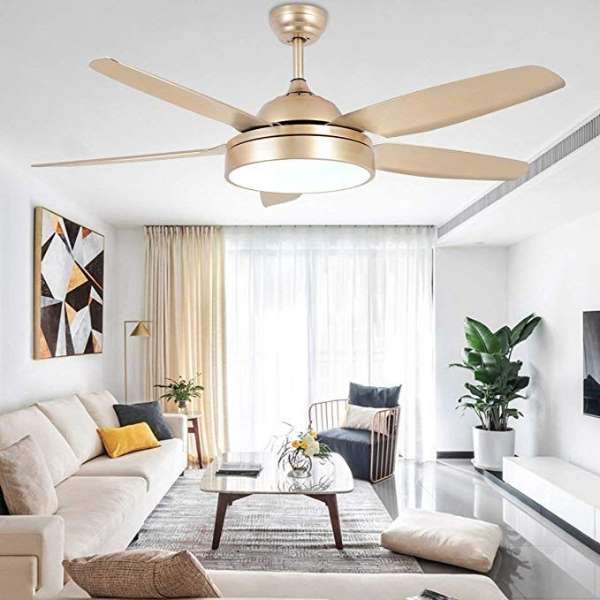The humble ceiling fan could be the answer to keeping your home cool this summer.
When it comes to choosing a practical and stylish cooling solution, you can’t go much further than the classic ceiling fan; it’s one of those household essentials.
The latest styles range from graceful good looks to fabulous statement-makers, and they’re useful all year-round to help keep you cooler in summer and warmer in winter.

Ceiling fans are great for energy-saving all year round and can work efficiently alongside an air conditioner to reduce running costs, or by themselves to create a cooling breeze for any room – indoors or out. Most ceiling fans use only as much power as a traditional 60-watt light globe, so you can feel cool for as little as 1 cent an hour (however, this can vary depending on your energy provider, fan size and fan use).
Most ceiling fans have a reverse mode meaning you can use your fan to circulate cool air in summer and warm air in winter. With low noise and a range of functionality including light and remote options, there is bound to be a ceiling fan to suit your needs for your home.
There are many different styles of fans on offer, although the simple white units continue to be the most popular.
Before purchasing a fan, keep the following points in mind to help you choose what is right for you and your home.

Here’s what you need to know!
SIZE MATTERS
When it comes to ceiling fan, size is everything.
A small fan in a large room will have to work twice as hard to cool you off, while a large fan in a small room may create an uncomfortable amount of airflow.
For a small to medium-sized room up to 4m, select a fan with approx 120mm blades, while blades of approx 140mm will suit a room size of up to 6m. In a large, open-plan space, you may need two or more ceiling fans.

PERFECT POSITIONING
Blades need to be at least 2.1m from the floor. Most fans come with a ball canopy fixing method, which means fans can be mounted on sloping, vaulted or flat ceilings.
For high or raked ceilings, an extension rod might be desired to actually bring the fan down to an efficient height.
In a small room with one fan, centring it is logical for both aesthetics and efficiency.

However, in a large bedroom, it might make better sense to position it over the bed for relief on hot nights.
In an expansive, open-plan room, consider using fans to ‘zone’ spaces, such as placing one over your sitting area and one above the dining table.
Be aware that fans need to be fitted securely to joists or blocking and should be positioned away from downlights to prevent flickering.
“There’s no hard and fast rule for this distance. “It depends on how far the fan is from the ceiling and the angle of light from your LED downlights. Ask your electrician for advice.”
POWER BENEFITS
Fans don’t cool the air; they just move it around the room.
“The faster the air moves over your skin, the more it works to evaporate perspiration, which is the mechanism your body uses to cool itself,”
A ceiling fan demands just a fraction of the power needs of an air conditioner, and using both together can reap serious energy-saving benefits.
“The two work well in tandem by dropping the initial temperature of a room, and then circulating that colder air,”
There are similar benefits in cold months, when reverse-function ceiling fans can be switched over to run clockwise, pushing down the available heat to warm the room better – a bonus for high-ceilinged rooms and even outdoors.
“Used in conjunction with high outdoor heaters, this function makes your outdoor room a perfect entertaining spot all year round,”

STYLE GUIDE
For style cues, look at the design of your home, as well as the effect you want as ceiling fans come in varying shapes and colours to work in harmony with your personal style.
If you have a high ceiling, a bolder style of the fan will draw attention, which in turn will draw your eye up, accentuating the ceiling height. In smaller rooms, you may consider a streamlined effect, so that it ‘disappears’.”
Fan blades are typically made of metal, plastic, timber, or plywood, with the choice of materials influencing the price.
Some fans have built-in lights, which solves the dilemma presented by making your fan, rather than a pendant light, the centre point of the room. Typically, the light can be operated independently so the fan can remain off even when the light is on.

ALWAYS WORK WITH A PROFESSIONAL
To ensure that your ceiling fan or fans are properly installed, always hire a licensed electrician. Having a professional install your fan also ensures that your warranty is not voided.
Contact a Licensed Electrician in Brisbane for Your Home Electrical Maintenance, Upgrades and Repairs

Installation, repairs, upgrades, lighting advice for your home and outdoor spaces. No matter what your home renovation plan calls for, you can trust Allyn White.
With over 45 years of experience in all aspects of domestic, industrial, commercial and emergency electrical work, Allyn will be able to assist with your electrical problems in Brisbane.
For a free quote by a licensed electrician call 0416 235 641 to arrange a time to discuss your electrical requirements.
Our charge out rate remains the same during the week, weekends and after hours, so don’t hesitate to contact us today!
Source: homestolove.com.au/


